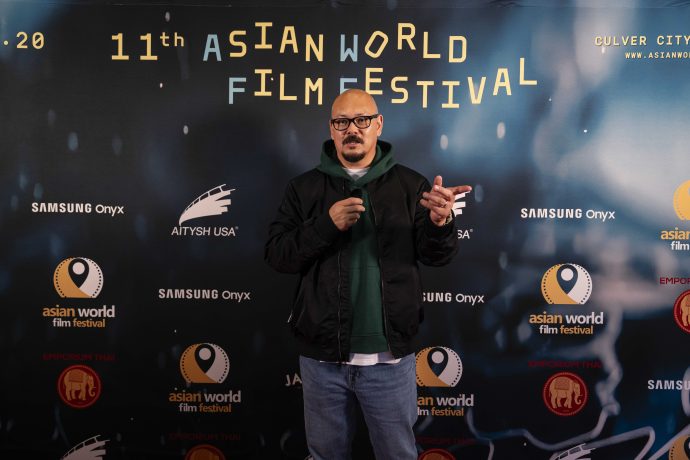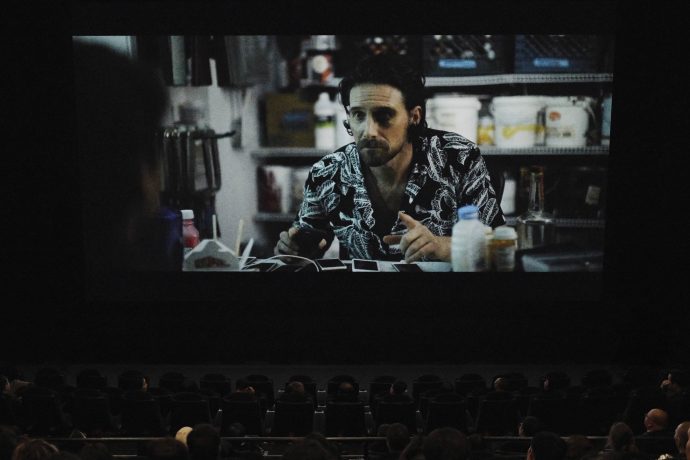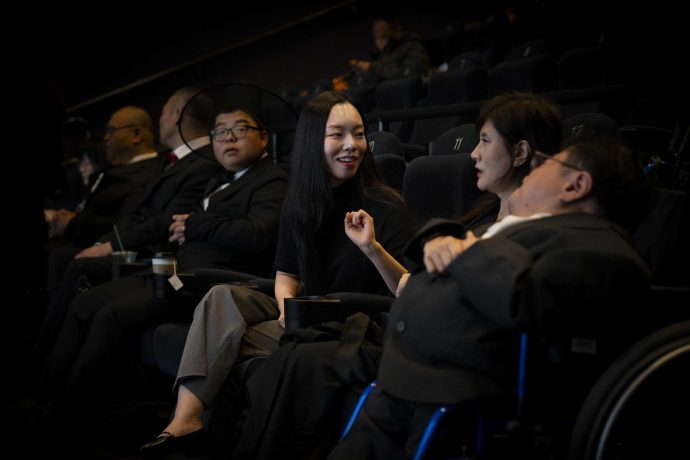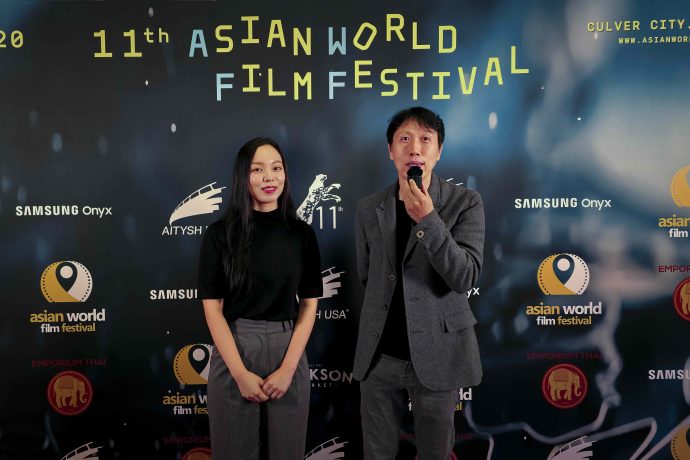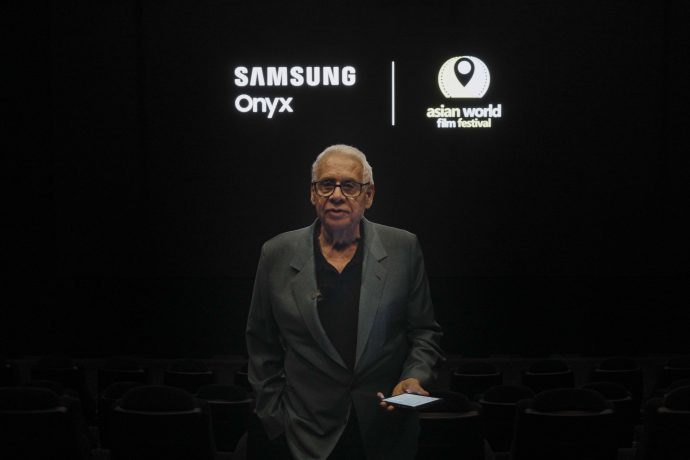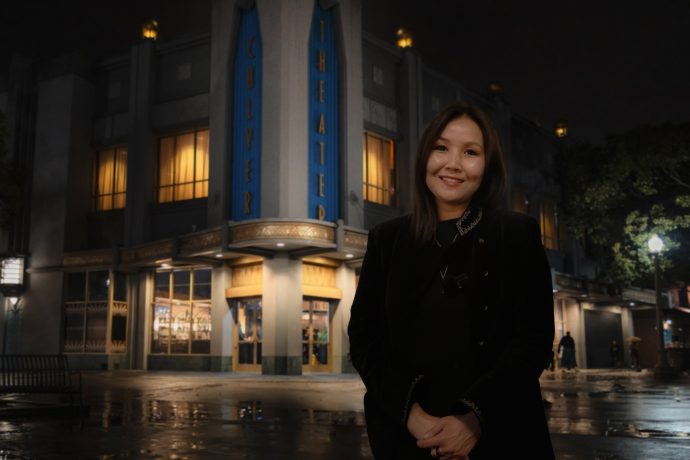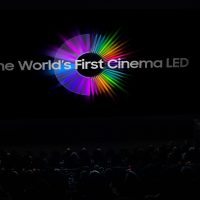LA-based filmmaker Zenon Samuels, who attended the festival and works extensively with nighttime visuals and neon-heavy palettes, echoed that sentiment after experiencing an Onyx screening for the first time. “The blacks are super dark, and with a film that’s so bright and colorful, the high dynamic range made the colors really pop and helped bring the energy and nighttime aesthetic to life.”

LA-based filmmaker Zenon Samuels share their viewing experience following an Onyx auditorium screening.
Together, these voices reflected a consistent theme: Onyx didn’t alter their films — it respected and faithfully recreated the choices behind them. For directors and performers seeing their work in this format, the experience felt both cinematic and deeply personal.
Audiences Rediscover What Cinemas Can Be with Samsung Onyx
Festivalgoers — many encountering Onyx for the first time — described a level of clarity and contrast that felt distinct from traditional projection.
New York attendees Jack Joyce and Matthew Gallopo noted how the presentation shaped their experience: “Those darker colors — and not having that graininess — kind of put you in the moment a little bit. It was cool,” Joyce said. Gallopo added, “The color certainly popped, and a lot of it was pretty crisp.”

Festival attendees, Matthew Gallopo (left) and Jack Joyce talk about their impression of the Onyx screen at AWFF 2025.
For some, the impact was emotional as much as technical.
Entertainment lawyer Jesse Weiner, who watches films professionally as part of his work, noted how the detail and richness altered the way he connected with the narrative unfolding onscreen. “Watching this film on Samsung Onyx, the picture was bright, rich… about as good as I can imagine seeing a film with that kind of quality and texture,” he added. “It looked very lifelike — almost like being immersed in the action of the film.”

Jesse Weiner, a New York–based entertainment lawyer, describes how the picture quality influenced the way he connected with the film.
Others reflected on what experiences like this might mean for the future of theaters. As streaming, gaming and home entertainment rapidly evolve, festivalgoers were struck by how an elevated cinema environment can bring people together again.
“Innovations in the cinema industry should help audiences truly see the story, and Samsung’s Onyx screens do just that.”
– Georges N. Chamchoum, Executive Director, AWFF
Across ages, backgrounds and filmmaking experience, the audience conversations pointed to the same conclusion: cinema remains powerful — and when the screen elevates rather than competes with the storytelling, the theatrical experience becomes even more compelling.

The Culver Theater lobby buzzes with filmmakers, audiences and industry guests as AWFF 2025 unfolds.
A Thoughtful Dialogue on the Future of Cinema
At this year’s festival, Samsung also hosted the panel discussion “Redefining the Cinema Experience with Samsung Onyx,” bringing together leading voices shaping the craft and technology of modern filmmaking. The panel featured:
- Glenn Gainor, CEO & Producer, Hollywood Ventures Group
- Steven Poster (ASC, CSC), Board Member, 6P Color; President Emeritus, International Cinematographers Guild Local 600
- Philip Holland, Director, Cinematographer, Digital Cinema Specialist & Color Scientist
- Craig German, Former C-Suite Executive, Amazon Studios and Paramount
Over the hour-long conversation, the panelists explored how advancements in HDR, color accuracy and display technology are reshaping both creative possibility and audience expectation. Much of the discussion focused on how deeper blacks, wider color gamuts and consistent presentation can reinforce cinematic emotion rather than alter it.
“We had the ability to capture on film, but not to project it—until now.”
– Glenn Gainor, Head of Production, Hollywood Ventures Group
Gainor reflected on the shift in audience expectations as viewing environments improve across the board, noting, “Clearly, I work in the movie business, so my home system is probably pretty good. never going to be as good as what we just saw. This is an entirely different, immersive experience.”

Glenn Gainor (center) shares his perspective on the future of theatrical storytelling during the panel session, joined by cinematographers and experts from across the industry.
Steven Poster spoke to how companies and the technology they develop can support—not interfere with—creative intent. “Samsung was one of the first to listen to creators with filmmaker mode—and that really mattered,” he said. “Motion interpolation destroyed suspension of disbelief, and now we can have that back.”
Holland pointed out how emissive displays strengthen emotional immersion by revealing details often lost in projection. “Because this tech can achieve such deep black, you don’t get milky shadows,” he said. “In a room like this, there were moments when you couldn’t see the edge of the frame—you felt like you were there.”

Philip Holland (far right) discusses the role of HDR and contrast in modern cinematic storytelling during the panel session.
That depth and precision became a larger theme as the panel discussed the creative range made possible by HDR. Gainor described it as an expansion of storytelling itself: “The art of storytelling allows us to get the darkest of dark and the brightest of bright.” Poster added: “We had the ability to capture it on film, but not to project it—until now.”

Panelists discuss the evolving landscape of theatrical storytelling during ‘The Future of Cinema Experience with Samsung Onyx’ session at AWFF 2025.
AWFF 2025: Where Art and Technology Meet
During the festival, one theme echoed across screenings, hallways and panel rooms alike: when the viewing experience respects the filmmaker’s intent, the connection between audience and story becomes stronger. That idea also shaped how AWFF leadership reflected on this year’s partnership with Samsung.
Executive Director Georges N. Chamchoum—an Emmy and multiple award-winning film director and producer—said, “AWFF has always been about cultural exchange, introducing Asian filmmakers to the world and giving their stories the visibility they deserve. Samsung’s support strengthens that mission.” He added that “innovations in the cinema industry should help audiences truly see the story, and Samsung’s Onyx screens do just that.”
Co-Founder and Managing Director Asel Sherniyazova highlighted the responsibility of presenting films with care: “A film may travel across continents before reaching our stage. Seeing it presented with this level of precision gives filmmakers confidence that their work is being treated with respect.”
